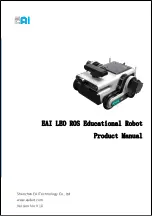
10
E101887#1
6.5 Assembling the gearbox
6.5.1 The marked holes in the side angle brackets (11) are used as follows:
- Insert a machine screw (18) M3 x 35mm in each of the holes marked 1 / 2:
- The motor is clamped between the slotted holes marked 3
- The axle (21) 3dia x 95mm is inserted in the hole marked 4
- The axle (5) 3 x 70mm is inserted in hole 5
6.5.2 Place the angle brackets (11) so that the right angled parts face outwards.
Insert the motor in between the holes (3) place the two set screws in the holes 1 & 2, at the same time add the
plastic distance pieces (26) . Place the nuts (17) on the ends of the set screws and tighten the whole assembly
so that the motor is clamped between the brackets
6.5.3 Insert the axle (21) in hole 4 and the axle (20 ) in the hole marked 5. Centralise both axles.
6.5.4 Slide the motor pinion gear (24) on to the motor shaft.
Slide the brass tube spacer (27) on the first axle (21) and then the white gear (23 loose fit). Place it such a po-
sition that it engages cleanly with the motor pinion.
The double gear ( 22, tight fit) is pushed on the axle (20) until it engages with the white gear (23)
The second double gear ( 22 tight fit) is now placed on the axle (21) until it engages with the red gear (22) ar-
range the gears as necessary, so that they engage correctly.
On the opposite side of axle (21), add a distance piece (30). Slide this on until it reaches the angle bracket and
there is only a little bit of play.
6.5.5 Insert a reducer (29) into the centre each wheel (9b) and press the wheels left and right on the axle shaft (21).
Note
:
Due to the tolerance in the individual parts, you may find that you have to glue the reducers into
the wheel centres. To stop the finished rickshaw from slipping on smooth surfaces glue a rubber
band (31) around each of the wheels
17
17
29
9
9
22
22
23
18
18
30
26
10
1
2
3
4
5
11
11
11
24
27
20
21
Depending on the
surface add a rub-
ber band (31)
around the wheel






























